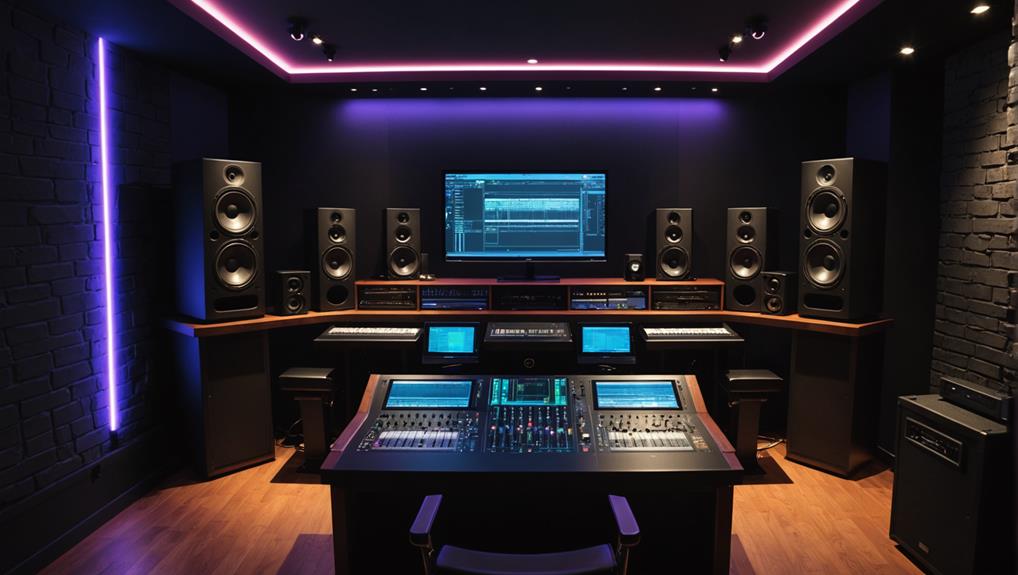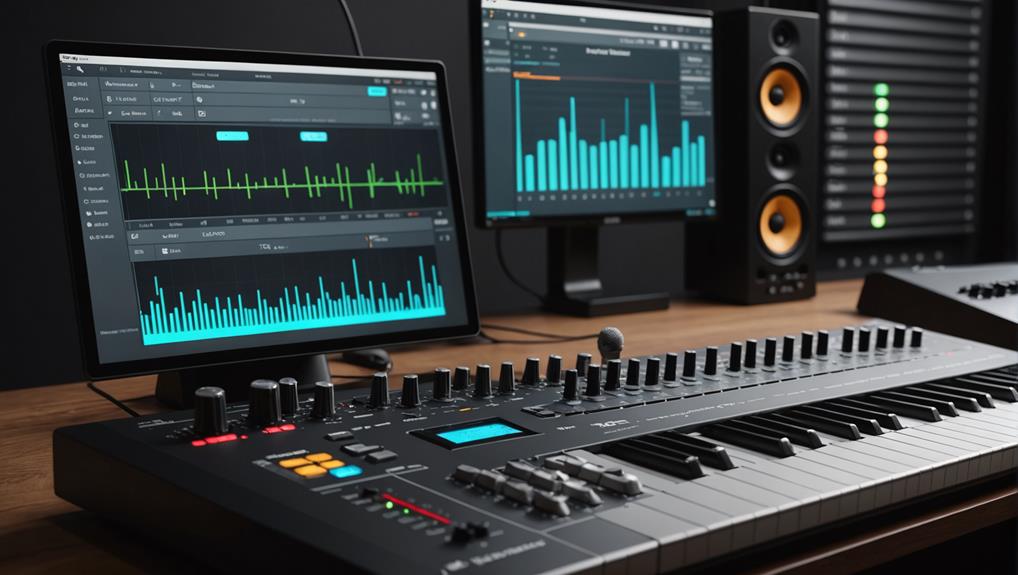For DIY audio mastering success, you need high-quality tools tailored for precision. Start with flat response monitors; they’ll guarantee your mixes translate accurately in any playback environment. Don’t overlook a premium DAC; devices from brands like Benchmark or RME offer superior signal fidelity essential for critical listening. Enhance your space acoustically with diffusers and bass traps to control reflections and achieve a balanced mix. Invest in mastering software like iZotope Ozone 9 for automated assistance and Mastering the Mix Reso to pinpoint and treat resonances. Consider advanced plugins such as the SSL Fusion Stereo Imager to widen your stereo field. You’ll find mastering a mix smoother if you explore these strategic enhancements.
Key Takeaways
- iZotope Ozone 9 offers AI-enhanced mastering for precision adjustments and user-friendly controls.
- Sonnox Oxford Inflator increases loudness while maintaining dynamic integrity.
- Mastering the Mix Reso targets and reduces unwanted resonant frequencies effectively.
- IK Multimedia T-Rex Classic Clipper provides soft clipping to add warmth without distortion.
- SSL Fusion Stereo Imager expands the stereo field, enhancing spatial depth and clarity.
Selecting the Right Monitors
To achieve ideal audio mastering results, you must carefully select monitors that offer a flat frequency response and precise sound reproduction. Monitors with a flat frequency response guarantee that no frequency is artificially boosted or suppressed, allowing you to hear your mix as it truly is. This accuracy is essential for making informed decisions about your audio’s balance and tonality.
When selecting monitors, also consider models with built-in room correction features. These can automatically compensate for acoustic imperfections in your workspace, which might otherwise color your perception of the mix. Monitor placement and acoustic treatment are equally important. Proper placement can greatly improve your listening experience. Monitors should be positioned at ear level and angled towards you, forming an equilateral triangle with your listening position. This setup helps in achieving a detailed stereo image and precise sound localization.
Additionally, integrating acoustic treatment can significantly enhance the accuracy of what you hear. Absorption panels, bass traps, and diffusers minimize room reflections and standing waves, providing a more consistent and reliable listening environment. Don’t forget to test multiple monitors in your actual mastering space, as each room interacts differently with sound, affecting what you hear.
Choosing a Quality DAC
Selecting a high-quality DAC is vital for guaranteeing that digital audio is converted to analog with utmost precision during mastering. A quality DAC, or digital-to-analog converter, plays a pivotal role in how faithfully your master tracks reproduce the original recordings. When considering DAC selection tips, prioritize models that offer low total harmonic distortion (THD) and high signal-to-noise ratio (SNR). These specs are essential as they affect the clarity and detail of the audio output.
In your DAC brand comparison, look into whether the DAC is integrated within an audio interface or if it’s a standalone unit. Standalone DACs often provide superior performance in noise reduction and signal precision—key for mastering where every detail counts. Brands like Benchmark, RME, and Grace Design are renowned for their engineering quality and reliability in professional audio environments. Each brand offers unique features, such as customizable filters or advanced jitter reduction, which can further refine your sound.
Investing in a high-quality DAC won’t only elevate the accuracy of your audio playback but also ensure that your mastering process meets professional standards. This enhancement in audio fidelity is essential for a mastering engineer aiming for the best possible end product.
Optimizing Your Mastering Space
Optimizing your mastering space involves strategically placing acoustic treatments like diffusers and bass traps to minimize reverberation and frequency buildup. Acoustic treatment techniques aren’t just about dampening; they’re about precision. To achieve a balanced sound, positioning diffusers on rear and side walls reduces early reflections that can color your perception of the mix. Bass traps in corners tackle low-frequency accumulations, ensuring a clearer bass response.
Monitor positioning is equally vital. Your monitors should be at ear level, forming an equilateral triangle with your listening position. This setup isn’t just about comfort; it’s about accuracy. Ensuring your speakers are correctly separated and angled directly towards you prevents phase issues and delivers a true stereo image.
Essential Mastering Software
After setting up your mastering space, the next step involves choosing the right software to fine-tune your audio tracks effectively. Mastering software not only refines your sound but can profoundly impact your final product. Here’s a breakdown of three essential tools that should be part of your arsenal:
- iZotope Ozone 9: A leading AI mastering tool, Ozone 9 offers a complete suite that’s especially user-friendly for beginners. Its AI Assistant analyzes your tracks and suggests optimizations, streamlining your mastering workflow strategies and ensuring professional results even if you’re not an expert.
- Sonnox Oxford Inflator: This tool is perfect for maintaining the dynamics of your track while increasing perceived loudness. Unlike traditional compressors, the Inflator adds warmth and presence without squashing your mix, making it an indispensable tool for achieving commercial-quality loudness without losing dynamic impact.
- Mastering the Mix Reso: This AI-driven plugin focuses on identifying and reducing unwanted resonant frequencies. It’s particularly useful for cleaning up mixes where certain frequencies overpower others, ensuring a balanced and smooth output.
Integrating these tools into your mastering workflow can dramatically enhance the quality and emotional impact of your music, making your tracks ready for professional release.
Advanced Mastering Plugins
To elevate your mastering process, consider incorporating advanced plugins like IK Multimedia T-Rex Classic Clipper and SSL Fusion Stereo Imager, which enhance sound quality through precise, technical adjustments. The T-Rex Classic Clipper offers a soft clipping setting that sidesteps harsh digital distortion while adding warmth, essential for maintaining organic sound textures. The SSL Fusion Stereo Imager, on the other hand, broadens your stereo image without muddying your mix’s low end, a feature modeled meticulously after SSL’s renowned hardware processors.
Further refining your mastering chain, the Sonnox Oxford Inflator can dramatically increase your master’s perceived loudness without the artifacts introduced by traditional compression. This maintains the dynamics and life of your mix, ensuring a polished yet vibrant final product. Mastering the Mix Reso, an AI-driven plugin, excels in identifying and attenuating resonant frequencies subtly, thereby smoothing out any unwanted peaks in your mix.
Lastly, iZotope Ozone9 integrates AI mastering assistants, offering a detailed suite that fits seamlessly into your mastering workflow. This plugin guarantees compatibility with a wide range of production software, streamlining your process and allowing for intricate, nuanced adjustments across various modules.
Frequently Asked Questions
What Tools Do You Need for Mastering?
For mastering, you’ll need quality mastering hardware and effective acoustic treatment. Invest in a flat-response speaker system, a high-end DAC, and room treatments like diffusers to guarantee precise audio reproduction and analysis.
What Software Is Best for Mastering Music?
For mastering music, iZotope Ozone9’s your best bet. It offers tailored adjustments for various genres, supports mastering environments, and fits within a mastering budget, providing professional output with its advanced limiter and AI assistant.
What Plugins Do Professionals Use for Mastering?
Professionals use advanced plugins like T-Rex Classic Clipper and SSL Fusion Stereo Imager for mastering. Regular plugin updates impact hardware preferences, ensuring compatibility and enhancing processing power for precise, high-quality audio mastering.
What Makes a Good Audio Master?
A good audio master balances frequencies and manages dynamic range considerations effectively. You’ll achieve clarity and enhance stereo field through meticulous EQ, compression, and spatial effects, preserving the music’s original intent.
Conclusion
Now that you’re equipped with high-quality tools and insights, you’re set to master your tracks with precision. Make sure your monitors are accurately placed and your DAC delivers pristine clarity. Tailor your mastering environment for the best sound.
Harness your mastering software to sculpt dynamics and tone meticulously. Finally, leverage advanced plugins to refine and enhance. With these strategies, you’ll achieve professional-grade audio masters that stand out in today’s competitive music landscape.




